
Hypericum socotranum is a species of flowering plant in the Hypericaceae family which is endemic to the island of Socotra in Yemen. Its natural habitats are subtropical or tropical dry forests and rocky areas.
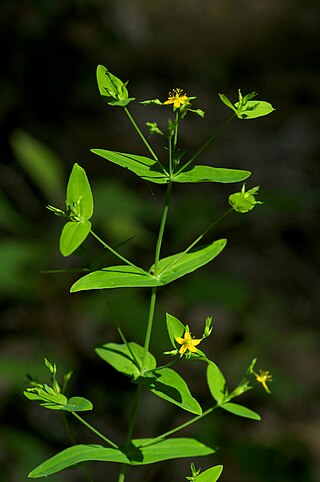
Hypericum mutilum is a species of St. John's wort known by the common name dwarf St. John's wort. It is native to parts of North America and is present in other parts as an introduced species. It is an annual or perennial herb taking a multibranched erect form up to about 60 centimeters tall. The oval green leaves are one or two centimeters long and are covered in tiny glands. The inflorescence is a compound cyme of tiny flowers. H. mutilum subsp. mutilum and subsp. boreale have a diploid number of 16, and H. mutilum subsp. boreale can have a diploid number of 18.
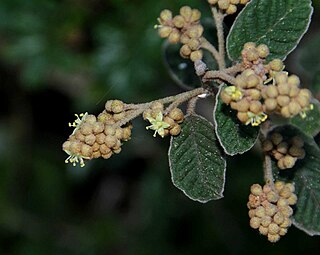
Pomaderris oraria, commonly known as Bassian dogwood, is a species of flowering plant in the family Rhamnaceae and is endemic to south-eastern Australia. It is a compact shrub with hairy branchlets, hairy, elliptic leaves and panicles of hairy, greenish to cream-coloured or crimson-tinged flowers.

Pomaderris paniculosa, commonly known as scurfy pomaderris, is a species of flowering plant in the family Rhamnaceae and is native to Australia and New Zealand. It is a shrub with hairy branchlets, round to elliptic or egg-shaped leaves with the narrower end towards the base and panicles of hairy, cream-coloured to greenish, sometimes crimson-tinged flowers.

Prostanthera serpyllifolia, commonly known as small-leaved mint-bush, is a species of flowering plant in the family Lamiaceae and is endemic to southern Australia. It is a small shrub with small egg-shaped leaves and bright pink to red or metallic bluish-green flowers.
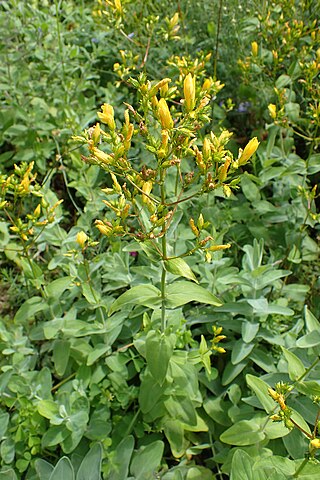
Hypericum annulatum is a species of flowering plant in the family Hypericaceae. It is a perennial herb of varying heights which grows upright, with more than a hundred flowers of a golden yellow color. First described in 1827, the species has a wide distribution from Eastern Europe to East Africa, and its appearance can vary greatly based on its geographic location. It has been used in Bulgarian folk medicine, and has more recently been investigated for its effectiveness in slowing the growth of or killing certain types of human cancer.
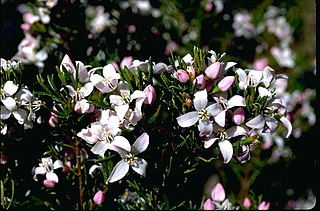
Boronia citriodora, commonly known as lemon-scented boronia, lemon plant or lemon thyme, is a woody shrub that is endemic to Tasmania. It has pinnate leaves and white to pink flowers that are arranged singly or in groups of up to seven, in the leaf axils or on the ends of the branches.
Hypericum cuisinii is a perennial herb in the genus Hypericum, in the section Adenosepalum. The herb has pale yellow flowers and occurs in Greece and Turkey.

Hypericum canadense, known as Canadian St. Johns-wort, lesser St. John's wort, and lesser Canadian St. Johnswort, is a flowering plant in the genus Hypericum. It is a yellow-flowering annual or perennial herb native to North America and introduced to Ireland and The Netherlands. The specific epithet canadense means "Canadian".

Hypericum undulatum, the wavy St Johns Wort, is a herbaceous perennial flowering plant native to western Europe and northern Africa. The specific name undulatum is Latin, meaning "wavy" or "undulated", referring, just as the common name, to the wavy leaf margins of the herb. The plant has a diploid number of 16 or 32.

Hypericum phellos is a species of shrub or small tree in Hypericumsect. Brathys. The species is found in Colombia and Venezuela on scrubby slopes and moist woods.

Hypericum majus, the greater Canadian St. John's wort, is a perennial herb native to North America. The specific epithet majus means "larger". The plant has a diploid number of 16.

Hypericum humboldtianum is a species of shrubby flowering plant in the St. John's wort family Hypericaceae native to Colombia and Venezuela.
Hypericum assamicum is a species of flowering plant in the St. John's wort family, Hypericaceae. It is endemic to India. Hypericum assamicum is one of two species of Hypericum in the section Hypericum sect. Sampsonia.

Cyanothamnus inflexus is a plant in the citrus family Rutaceae and is endemic to tablelands near the New South Wales - Queensland border in Australia. It is an erect, woody shrub with pinnate leaves and up to seven white to pink four-petalled flowers in the leaf axils. Boronia bipinnata is similar but has larger, bipinnate or tripinnate leaves and smaller sepals and petals.
Hypericum harperi, the sharplobe St. Johnswort or Harper's St. John's wort, is a perennial flowering plant in the family Hypericaceae. It is an aquatic herb native to southeast North America. H. harperi has a diploid chromosome number of 24.

Hypericum heterophyllum is a flowering plant in the Hypericaceae family and is the only species in Hypericum sect. Heterophylla.

Triplarina volcanica is a species of flowering plant in the myrtle family, Myrtaceae and is endemic to Queensland, where it is only found in three mountainous areas. It is a shrub with elliptical to egg-shaped leaves with the narrower end towards the base and flowers with five sepals, five white petals and fourteen to sixteen stamens.

Hovea asperifolia is a species of flowering plant in the family Fabaceae and is endemic to south-eastern continental Australia. It is a shrub with hairy branchlets, narrowly oblong to narrowly linear leaves with stipules at the base, and mauve, pea-like flowers.
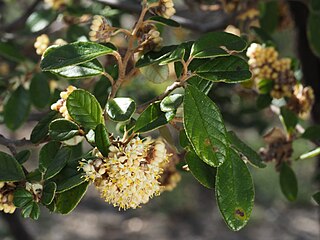
Pomaderris betulina, commonly known as birch pomaderris, is a species of flowering plant in the family Rhamnaceae and is endemic to south-eastern continental Australia. It is a shrub with hairy young stems, lance-shaped to oblong or elliptic leaves, and yellowish flowers.

















